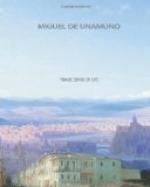and misshaped their doctrines in order to satisfy
their own vital yearnings. This is followed by
the statement of the will to live or hunger for immortality,
in the course of which the usual subterfuges with
which this all-important issue is evaded in philosophy,
theology, or mystic literature, are exposed and the
real, concrete, “flesh and bones” character
of the immortality which men desire is reaffirmed.
The Catholic position is then explained as the
vital
attitude in the matter, summed up in Tertullian’s
Credo quia absurdum, and this is opposed to
the critical attitude which denies the possibility
of individual survival in the sense previously defined.
Thus Unamuno leads us to his inner deadlock:
his reason can rise no higher than scepticism, and,
unable to become vital, dies sterile; his faith, exacting
anti-rational affirmations and unable therefore to
be apprehended by the logical mind, remains incommunicable.
From the bottom of this abyss Unamuno builds up his
theory of life. But is it a theory? Unamuno
does not claim for it such an intellectual dignity.
He knows too well that in the constructive part of
his book his vital self takes the leading part and
repeatedly warns his reader of the fact, lest critical
objections might be raised against this or that assumption
or self-contradiction. It is on the survival
of his will to live, after all the onslaughts of his
critical intellect, that he finds the basis for his
belief—or rather for his effort to believe.
Self-compassion leads to self-love, and this self-love,
founded as it is on a universal conflict, widens into
love of all that lives and therefore wants to survive.
So, by an act of love, springing from our own hunger
for immortality, we are led to give a conscience to
the Universe—that is, to create God.
Such is the process by which Unamuno, from the transcendental
pessimism of his inner contradiction, extracts an
everyday optimism founded on love. His symbol
of this attitude is the figure of Don Quixote, of whom
he truly says that his creed “can hardly be called
idealism, since he did not fight for ideas: it
was spiritualism, for he fought for the spirit.”
Thus he opposes a synthetical to an analytical attitude;
a religious to an ethico-scientific ideal; Spain,
his Spain—i.e., the spiritual manifestation
of the Spanish race—to Europe, his Europe—i.e.,
the intellectual manifestation of the white race, which
he sees in Franco-Germany; and heroic love, even when
comically unpractical, to culture, which, in this
book, written in 1912, is already prophetically spelt
Kultura.
This courageous work is written in a style which is
the man—for Buffon’s saying, seldom
true, applies here to the letter. It is written
as Carlyle wrote, not merely with the brain, but with
the whole soul and the whole body of the man, and
in such a vivid manner that one can without much effort
imagine the eager gesticulation which now and then
underlines, interprets, despises, argues, denies, and




